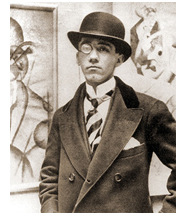Gino
Severini
(Cortona, 1883 - Paris, 1966)
 Gino Severini, one of the leading artists of the Futurist movement, began experimenting with etchings in 1909 after he moved to Paris. In the beginning he focused primarily on academic subjects such as portraits of friends and relatives and small country scenes. In 1916 the important linocut La Modiste, with Futurist and Cubist elements, was published and reproduced in the Parisian magazine Sic, reflecting his growing influence in Parisian art circles. Gino Severini, one of the leading artists of the Futurist movement, began experimenting with etchings in 1909 after he moved to Paris. In the beginning he focused primarily on academic subjects such as portraits of friends and relatives and small country scenes. In 1916 the important linocut La Modiste, with Futurist and Cubist elements, was published and reproduced in the Parisian magazine Sic, reflecting his growing influence in Parisian art circles. Gino Severini, as well as many early 20th century artists, was inspired by characters from the “Commedia dell’ Arte” (Artistic Comedy), a form of Italian improvisational theater dating back to the second half of the16th century, with story lines built around stock characters such as, among others, Pantalone, Colombina, Pulcinella, Pedrolino and Arlecchino. In 1922, as a continuation of his paintings, Severini completed his first lithographs of Commedia dell’ Arte characters. His lithograph Harlekin-Familie was part of the 1925 Bauhaus–Weimar portfolio dedicated to the graphic works of avant-garde Italian and Russian artists. In the 1930 Fleurs et Masques portfolio, Severini completed a series of sixteen gouaches which were then published as color pochoirs. In 1939, Severini returned to Italy and to experimenting with linocuts, producing Ballerina and Gravure Futuriste. Upon the artist’s return to Paris after World War II, he became much more involved in color lithography. He was often commissioned by publishers, such as l’Oeuvre Gravée and Il Bisonte, among others, to create new images, which led to an extended period of continuous printmaking. From 1952 until 1965, Severini completed 28 color lithographs and 3 etchings reflecting past themes (Dancers, Commedia dell’ Arte characters and Still Lifes) and styles (Cubism, Futurism and Classicism.) During this period, his graphic works acquired a prominent position in his creative output, perhaps because they gave him the opportunity to expose his images to a much larger audience. “Gino Severini – Form and Color: The Graphic Works 1909-1965” is a rare retrospective illustrating the full range of the artist’s graphic oeuvre. |